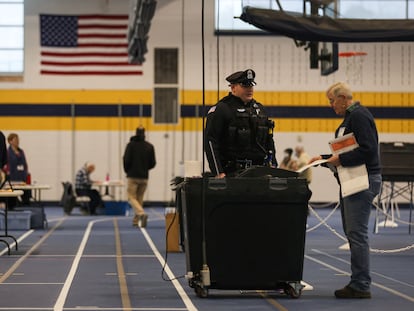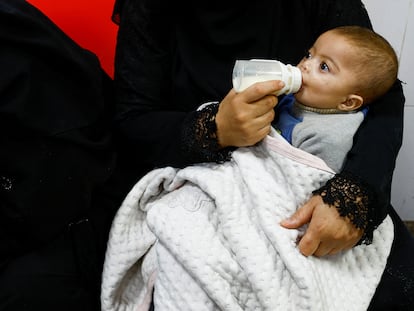EU and US consider delivering humanitarian aid to Gaza by sea
The Israeli army prevented the first U.N. World Food Program convoy in three weeks from entering the northern Gaza Strip; it ended up looted by a hungry crowd
The obstacles that Israel has imposed on the delivery of humanitarian aid by land to a starving Gaza and the limitations of airdrops (as several countries have done, most recently the United States) have prompted the consideration of a third alternative: a humanitarian corridor through the Mediterranean Sea. This Friday, the president of the European Commission, Ursula von der Leyen, will travel to Cyprus, the EU country closest to the Gaza Strip (some 320 miles away), to study the project, her spokesman, Eric Mamer, said Wednesday. “Our efforts are aimed at making sure that we can provide assistance to the Palestinians [...]. We all hope that the opening [of this corridor] can take place very soon,” he added. A Cypriot government spokesman told Reuters that von der Leyen will visit “the infrastructure related to some phases of the plan” with the country’s president, Nikos Christodoulides.
On Tuesday, U.S. National Security Communications Advisor John Kirby said that Washington is “exploring other channels to get aid into Gaza, including a maritime route. To that end, we are looking at both military and commercial options to move assistance by sea.”
The maritime plan has gained new momentum in the wake of the deaths of over a hundred Gazans last week when they chased an aid convoy and Israeli soldiers opened fire on unarmed civilians. The images of despair, the injured and bloodstained food have heightened international concern about the humanitarian crisis, caused mainly by Israel’s decision to use famine as a weapon of war. This event that shocked the world has led the United States to join in the airdrop of food, a controversial measure because the quantities are smaller, and it is considered a last resort. Jordan, France and the United Arab Emirates have already used this method. Any entry of aid into Gaza requires the green light from Israel, whether it comes by land from Egypt (which first checks the shipments and vetoes some supplies), by air or by sea, since it has controlled Gaza’s air and sea space since before the war.
A new failed overland delivery attempt to northern Gaza has highlighted the gravity of the situation. The U.N. World Food Program made another attempt on Tuesday, three weeks after announcing the stoppage of deliveries because two consecutive convoys and a driver had been assaulted by a mob, making them too dangerous.
The U.N. agency said the Israeli army forced the convoy of 14 trucks to turn back after three hours of waiting at the Wadi Gaza checkpoint, which marks the border between the northern area from which the Israeli army forcibly displaced most of the population at the beginning of the invasion. The trucks were then redirected to another area and “later stopped by a large crowd of desperate people, who looted the food, taking around 200 tons from the trucks,” it said in a statement. Asked by this newspaper about the episode, the Israeli army replied that it is investigating the incident.
“The only option”
The World Food Program has stated that “road routes are the only option to transport the large quantities of food needed to avert famine in northern Gaza,” where “hunger has reached catastrophic levels in the north of Gaza where children are dying of hunger-related diseases and suffering severe levels of malnutrition.” It noted that Gazans looted some 200 tons from Tuesday’s convoy. The same program airlifted aid that day, with the help of Jordanian military aviation. The supplies did not exceed six tons.
The EU is looking into the possibility of indirectly joining the airdrop deliveries, Crisis Management spokesman Balazs Ujvari said. “We are looking at this possibility very closely, with the constraint that the EU does not have the means to carry it out and it will have to be done through organizations on the ground or member states, through the Civil Protection Mechanism,” he said.
This Tuesday, the World Health Organization decried the “unprecedented” deterioration of the state of nutrition in the Gazan population during the four months of war: the rate of acute malnutrition — which causes irreparable emaciation or wasting away — in children has risen from 0.8% to 15.6%. The situation is most serious in the north, where hundreds of thousands of people remain. Israel keeps the bulk of the work of humanitarian organizations concentrated in the south of the Gaza Strip.
Sign up for our weekly newsletter to get more English-language news coverage from EL PAÍS USA Edition
Tu suscripción se está usando en otro dispositivo
¿Quieres añadir otro usuario a tu suscripción?
Si continúas leyendo en este dispositivo, no se podrá leer en el otro.
FlechaTu suscripción se está usando en otro dispositivo y solo puedes acceder a EL PAÍS desde un dispositivo a la vez.
Si quieres compartir tu cuenta, cambia tu suscripción a la modalidad Premium, así podrás añadir otro usuario. Cada uno accederá con su propia cuenta de email, lo que os permitirá personalizar vuestra experiencia en EL PAÍS.
¿Tienes una suscripción de empresa? Accede aquí para contratar más cuentas.
En el caso de no saber quién está usando tu cuenta, te recomendamos cambiar tu contraseña aquí.
Si decides continuar compartiendo tu cuenta, este mensaje se mostrará en tu dispositivo y en el de la otra persona que está usando tu cuenta de forma indefinida, afectando a tu experiencia de lectura. Puedes consultar aquí los términos y condiciones de la suscripción digital.
More information
Archived In
Últimas noticias
Most viewed
- Reinhard Genzel, Nobel laureate in physics: ‘One-minute videos will never give you the truth’
- Oona Chaplin: ‘I told James Cameron that I was living in a treehouse and starting a permaculture project with a friend’
- Pablo Escobar’s hippos: A serious environmental problem, 40 years on
- Why we lost the habit of sleeping in two segments and how that changed our sense of time
- Chevy Chase, the beloved comedian who was a monster off camera: ‘Not everyone hated him, just the people who’ve worked with him’











































